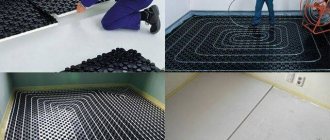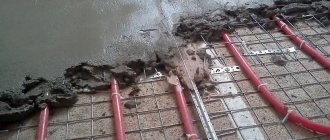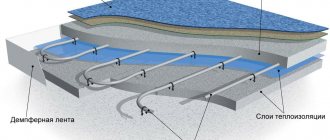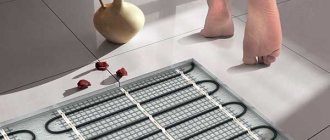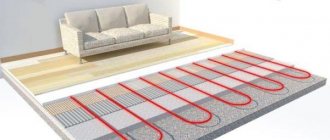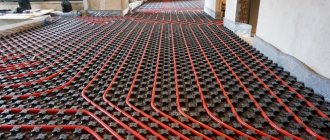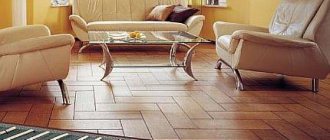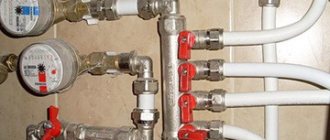Warm floors are an effective and comfortable option for heating a home. It can be used as a main or additional heat source, capable of providing the necessary microclimate in any room and conditions.
Water systems are considered the most effective underfloor heating designs, which have many advantages over alternative types of heating modules. They are economical, capable of automatically maintaining the heating mode and maintaining the necessary microclimate during short-term outages. Let's take a closer look at water heated floor systems.
Types of warm water floors
When choosing a heating design, take into account the type of installation, room parameters, coating materials, strength of supporting structures and the requirements.
The classic option is concrete technology, when the water floor is installed in a concrete screed with preliminary installation of insulation and moisture insulation.
There are also flooring systems made of wood or polystyrene. There are rack and modular types. To install a rack structure, use edged boards, and for a modular structure, use ready-made sheets (modules).
After laying the base, cover it with sheets of chipboard or plywood and lay a finishing coating of laminate or linoleum.
Pouring heated floor screed and installing finished floor covering
Among the final work on installing the heating system is pouring the screed. After this, it will be possible to install the finishing coating.
Filling the screed consists of the following steps:
- preparation of the floor surface: leveling, removing debris, puttying;
- rough screed equipment (preferably made from expanded clay concrete) and insulation;
- installation of mesh for reinforcement and damper tape around the perimeter;
- pipe laying.
The finishing coating is installed with the addition of a plasticizer for cement screed and small fractions of crushed stone.
After screeding, you can install the floor covering
Water heated floor installation
The liquid moves through the pressure pipeline, is discharged to the heating circuit, and as it passes through it it releases heat to the floor surface.
The cooled water returns back, entering the boiler and heating up again to the desired temperature.
Special limiters are installed in the base that connect the floor temperature with the volume of water in the heating circuit (so that the base is heated, creating an optimal microclimate).
Characteristics
The wooden floor structure consists of the following elements:
- base coat base;
- edged board, OSB, chipboard;
- aluminum distribution plates;
- pipelines for coolant;
- substrate for laying the finishing base;
- prefabricated screed GVLV;
- fine coating.
Wooden structures are used in old, frame and wooden houses, where a concrete screed is not suitable.
For installation, determine the appropriate option:
- modular type consists of ready-made elements;
- rack type is mounted from ready-made boards.
For the modular type, ready-made sheets of chipboard or polystyrene with grooves for installation of pipelines are used. The base is laid on logs, which are mounted in 60 cm increments on the old base or subfloor. The internal space is filled with a heat insulator.
Next, the modules are fixed to the logs, pipelines are laid and the system is connected to the hot water supply. Heat distribution plates made of metal with grooves into which plastic pipes are attached are laid out into modules.
The rack design is based on the use of boards with a thickness of 28 mm, which are laid at a distance of 20 mm from each other (to form grooves into which pipelines are mounted). Modular floors are used less frequently, but are durable and reliable.
The technique for laying a concrete system involves the use of screeds.
Scheme for laying a warm water floor:
- base;
- thermal insulation layer;
- reinforcing mesh;
- heating pipes;
- concrete pouring;
- substrate for the final coating and top layer (laminate, parquet).
Warm water floors are used in two-pipe heating with forced circulation of coolant and manifolds for distribution to equipment.
It includes the following elements:
- Boiler group and boiler. They create a non-stop supply of coolant to the risers (heating supply lines). After passing through the heating devices, the cooled coolant returns through the main line.
The boiler runs on solid or liquid fuel, pellets, from a heat pump, electricity, etc. The boiler room includes a pump, boiler, safety group and expansion tank;
- Radiator manifolds for pipes and heating devices;
- Return and supply lines that feed radiator manifolds, a mixing unit with a heated floor manifold. Cabinets with collectors are installed on each floor.
A suitable option in the heating design is to connect the boiler to the inlet to the pumping system. Due to the fact that the heating of the coolant reaches 35-45 C, a mixing unit is used to reduce this value. A two- or three-way valve is installed.
After this, the supply pipe for the heated floor is connected to a special manifold with outputs to circuits, thermostatic valves and flow regulators. Taps are placed on the supply and return pipelines (for possible shutdown of the operating circuit).
There are options for laying the contour:
- snake The technology is simple, but there is a drawback - the difference between the temperatures at the end and beginning of the circuit. Moving from the supply manifold to the return manifold, the coolant cools down. The method is suitable for installation in border areas;
- snail The technology is complex to implement, but ensures uniform temperatures;
- combined option. This type of installation is often used, in which the outer zones are laid with a snake, and the rest - with a snail.
Each method can use a variable masonry pitch, which in the outer zones is 100-150 mm, indoors 200-300 mm.
Pipes for warm water floors:
- made of metal-plastic. They are easy to install, hold their shape and are low cost;
- made of cross-linked polyethylene. It is inconvenient to work with them, since pipes made of this material straighten when heated;
- from copper. Pipes are expensive and must be covered with a protective layer due to corrosion.
How to calculate the required number of pipes?
After choosing the optimal type of pipeline, you should not rush into the purchase. The first step is to calculate how much material will be needed to install a high-quality heated floor.
In the “spiral” installation option, heat is distributed evenly over the entire surface due to the rational arrangement of the coils. There are practically no sharp breaks in the design, which removes the restriction on the use of pipes with a large bend radius
A laying diagram drawn on graph paper will help you make accurate calculations. A scale plan of the room is transferred to it, where the existing household appliances and large-sized furniture are displayed. The heating circuit is drawn in a section of free space.
There are two main laying schemes:
The recommended length of the pipeline in one circuit is no more than 80 meters. Otherwise, the coolant will cool down, reducing heating efficiency.
If the room is too large, it is advisable to divide it into separate sectors. The boundary gap between adjacent lines for uniform heating is no more than 35 centimeters - the interval should decrease in places of large heat loss. You should also take into account a 15-20 cm distance from the walls.
If you are unsure of your capabilities, it is wiser to turn to professionals to draw up a competent engineering project, select and install equipment. Although this involves additional costs, it more than pays off after a short time
When the drawing is ready, you can start making calculations. Everything is extremely simple: first, the total length of the contours is measured, then the resulting value is multiplied by the scale. It is better to add a few spare meters to the final figure.
Advantages of water heated floors
- efficiency. Heating large areas while reducing cash costs and water heating costs;
- uniform heat distribution and microclimate control;
- aesthetic design; there are no pipelines or heating radiators on the walls. Therefore, designers can implement different projects. In addition to a heated floor, a water heated towel rail can be used in the bathroom;
- adaptation to any energy sources, floor designs and materials;
- durability;
- safety and absence of electromagnetic field;
- readiness for installation of all finishing coating options (laminate, linoleum, parquet, etc.);
- operational installation.
When laying a wooden structure, the plus is the prevention of moisture ingress and rapid insulation.
The advantage of a concrete screed is reliable installation, strength and integrity of pipes, but the cost of such a floor will be higher due to concrete pouring.
Types of pipes used
To install a warm water floor, various types of pipes are used.
| Material | Advantages | Flaws |
| Copper | Long lifespan Resistant to microorganisms, corrosion, and temperature changes | Resistant to microorganisms, corrosion, and temperature changes Not compatible with steel products Reacts to hard water with high acidity content Expensive |
| Polypropylene | Durability Environmental safety Reasonable price | Installation temperature limitation – not lower than 15 degrees Inconvenient for installing a heated floor circuit. |
| Metal-plastic | Long service life Corrosion resistant Environmentally friendly High level of sound insulation | Afraid of open fire Lime deposits can form at the joints of connections, which leads to leaks |
| Cross-linked propylene | Resistant to temperature and pressure changes, mechanical damage Not subject to corrosion Chemical resistant Does not corrode Environmentally friendly Lasting | Does not tolerate prolonged exposure to direct sunlight When oxygen enters the structure, the service life is reduced |
All of them must have mandatory markings indicating the possibility of their use for heating devices.
To install a warm water floor, various types of pipes are used
Minuses
A water floor is suitable for furnishing private houses and cottages. For multi-apartment buildings with central heating, such a system will not be suitable, since it will be necessary to collect a lot of documents to obtain permission.
Other design disadvantages include:
- The need to perform complex calculations for installation;
- The need to raise the floor level by a few centimeters, reducing the height of the doors.
- If there are leaks on a concrete floor, you will have to open the base. The system is heavy and not suitable for old objects.
Therefore, first familiarize yourself with the advantages and disadvantages. It is better to install the floor in a house under construction, making the necessary calculations during the design, which will reduce installation costs.
Place of application
The most common place for using heated floors is in private homes. It should be taken into account that if the room does not have a large area, then you can use an electric heated floor, since the water structure requires more space for the placement of pipes. But if this system is used as the main one, and in rooms with a large area, it would be more advisable to purchase a water-based heated floor.
As for multi-storey buildings in which a centralized heating system is installed, it in no case provides for the use of heated floors. You can purchase a special system with a separate circuit, however, this option requires obtaining approval from utility or management companies.
How to choose
To choose a high-quality water floor, pay attention to the components:
- type of floor;
- finishing base;
- coolant temperature;
- room microclimate, etc.
According to the requirements of SNiP, the minimum thickness of the screed is 20 mm, but if reinforcement is not used, the figure increases to 40 mm (with a pipe diameter of up to 25 mm).
Above pipes, the thick layer does not exceed 55-65 mm in residential premises, car showrooms, fitness clubs and restaurants - up to 200 mm, for hangars and production workshops the figure rises to 300 mm.
For a water floor, pipes made of cross-linked polyethylene or polypropylene (with fiberglass) with a diameter of 16-20 mm at a critical pressure of 10 atm and a heating temperature of 95 degrees are suitable.
Control valves (to smoothly change the supply of coolant to the heating circuit) or shut-off valves (to completely disconnect the circuit from the heating) must be installed on the collectors. The manifold is equipped with an air valve and a drain outlet.
The manifold cabinet includes a pair of combs with valves. Design and develop it together with the heating, in accordance with the number of connected circuits. It is installed above the level of the structure, from where the pipes pass down.
Thermostats are installed in the collector group.
When calculating a water floor, the linear parameters of the rooms, the material and thermal insulation of the walls, the type of finished base, the parameters and type of pipelines used, and the temperature of the incoming coolant are taken into account.
Using these indicators, the length of the heating circuit, the pitch of the pipes and the layout of the screed are determined.
The water floor temperature is 29 C for the kitchen, corridors and living rooms. An exception is children's rooms, where a special operating regime is established. Near windows and external walls (with high heat losses) the temperature should be 35 degrees, and in bathrooms up to 34 C.
A properly designed and installed structure will save 12% of the released energy, preventing heat loss. Additional energy savings are provided by automatic regulators.
First, the heat loss of the house is determined, calculated taking into account the number of doors and windows, the nature of the insulation of the roof, floor and walls. Typically this figure is 40-300 W/m2.
The highest indicator is manifested in rooms with thin brick walls, without insulation, and the lowest - with excellent thermal insulation and double-glazed windows.
Heat losses are also compared with the normal output of a heated floor. It is taken into account that there remains a distance between the walls and the edges of the substrate.
That is, the total area of the system cannot exceed 70%, since the placement of household equipment and furniture in the room must be taken into account. Due to low power and limited space, the design may not heat the room completely.
The design power and the level of heat losses are calculated (the area is multiplied by the heat loss indicators). If the indicator exceeds the heat transfer, then the use of the system is irrational.
Design Features
A water heated floor is a pipeline laid on a layer of heat insulation in a certain configuration. A coolant circulates through the pipeline, heating the pipe and, accordingly, the floor covering.
In fact, a warm floor is a kind of radiator that occupies the entire area of the room and is located under the finishing coating.
However, it is distinguished from a conventional radiator by its low-temperature operating mode - the temperature of the heated floor does not exceed 40-45 ° C (sometimes it is raised to 50 ° C if operating conditions require it). If you apply a standard temperature of 70-80 °C to the heated floor loops, it will become impossible to walk on the floor or even be in the room.
To ensure low-temperature conditions, two methods are used:
- setting the heating boiler to supply water with an operating temperature of about 50 °C;
- using a mixing unit.
Both of these options have their own specifics and require a more detailed description.
Low temperature boiler
Using a boiler with a special heating mode allows you to reduce the composition of the equipment for heated floors.
The coolant enters the loops directly from the boiler outlet, often without even using a collector. As a rule, this option is used to power one loop, since it is almost impossible to ensure equal temperatures for several circuits under such conditions. Most often, heated floors of this type are found in small houses or in bathhouses, where it is necessary to heat the rest room or washroom.
This option is rarely used because it is unreliable and does not stand up to criticism. The coolant cools down even before it enters the heated floor loops. The only option for its use may be to place the boiler in close proximity to the system so that the liquid does not have time to release thermal energy. At the same time, adjusting the operating mode becomes significantly more complicated - you have to change the boiler settings, which is very difficult and always gives the expected result.
Mixing unit
This is a design that provides regulation of the temperature of a heated floor by connecting a fresh hot flow with cooled water from the return flow (as they say in everyday life - with the return flow). The difference between them is not too great, but it completely allows us to obtain the necessary reduction in the initial temperature to the required values. At the same time, the mixing unit does not just connect two flows - it can regulate their ratio by changing the temperature of the floor surface.
The main part of the mixing unit is a three-way valve. The supply line is connected to one of its inputs, and the return line is connected to the second. The output is a stream with a given temperature. The ratio is adjusted manually, or using a temperature sensor and servo drive. This option is preferable, since it allows automatic adjustment and does not require responding to any change in weather or climate conditions.
There are models of mixing units that operate on two-way valves. They operate more simply - a specified amount of return flow is mixed into the forward flow. This option is more primitive and does not save fuel - in any case, the maximum amount of water will have to be heated.
Loops
Since the coolant releases energy and cools, there is a limit on its length - up to 100 m. For a more uniform distribution of heating, not one long pipeline is used, but several shorter sections - loops. They are connected to the coolant source in parallel and laid on the subfloor as independent elements.
Heated floor loops must be the same length. This is not a strict requirement, but it is very important for organizing the uniform distribution of thermal energy.
If the coolant passes through two loops of different lengths, it will have a different temperature at the outlet. This is ineffective and impractical, since the consumption of thermal energy with equal opportunities will be completely different.
The loops are laid so that the distance between the turns is approximately the same at all points in the room.
Different schemes are used:
- spiral;
- snail;
- zigzag;
- single and double laying.
The last option is pipe laying methods that provide different options for distributing thermal energy. In the first case, the direct flow enters the loop, passes along its entire length and returns to the return. The second option is somewhat more complicated - the pipe is folded in half, the ends are connected to the direct and return lines, and then the circuit is laid with two pipes at once. As a result, hotter areas are located between cooler ones, which gives optimal heat distribution.
Collector
For connection, a special device is used - a collector. It is made in the form of a piece of pipe, to which a supply (or return) pipeline with coolant is connected at one end. The second end is usually plugged, or a thermometer (pressure gauge, etc., different options are possible) is installed.
There are holes with connecting elements along the entire length of the collector. Heated floor loops are connected to them. At the same time, the holes are through - hinges are attached to the bottom, and valves or servos are installed on top for automatic adjustment. The number of outputs can be different, which allows you to select a collector of one type or another for each design option for a heated floor. At the same time, the collectors can be connected to each other, increasing the number of outputs.
The ability to adjust each loop individually allows for more precise and fine-tuning of the heating mode. If the room is temporarily not in use, you can turn off the loops installed in it and not waste thermal energy in vain. In addition, you can set different temperatures in living rooms and corridors, which allows you to obtain more economical fuel consumption for the preparation of coolant.
Each loop is connected to two collectors - forward and reverse. A mixing unit with a circulation pump is installed between these collectors. You can purchase all the elements separately and connect them yourself, or buy a ready-made collector group for the required number of outputs. The first option requires skill and experience in assembling such systems, the second is more expensive, but provides a guarantee against possible errors.
Pipes
Heated floor loops require pipes that can withstand operating loads and are resistant to corrosion.
For this purpose, you can use the following options:
cross-linked polyethylene pipes;
corrugated stainless steel pipes;
polypropylene;
copper.
The most common are polyethylene or polypropylene pipes. This popularity is due to low prices and ease of installation - you can use regular compression fittings with them. No less popular are stainless steel corrugated pipes, which bend well and do not require the installation of a large number of fittings, which is typical for copper pipes.
Multiple soldering points make structures vulnerable to leaks. Moreover, if the installation of a copper pipe is done with high quality, the durability of the system will be maximum (sometimes it exceeds the service life of a building, for example, a frame house).
There are no fundamental requirements for the choice of material. Usually they proceed from the magnitude of the loads and the possibility of repairs - if it is planned to pour into the screed, they try to ensure maximum reliability in order to eliminate the need for repairs.
Which water heated floor is better
Components of the best water heated floor:
- concrete slab;
- waterproofing;
- damper tape;
- insulation;
- reinforcing mesh;
- pipes and concrete screed.
Waterproofing can be done with polyethylene film or special materials. The insulation is selected depending on the climate and the thermal insulation of the floors.
The contours are laid in a snail pattern. In the area of their largest accumulation, the part is covered with a heat-insulating tube.
Floor installation methods
When installing the system on a floor, which is most often wooden, you need to choose a method for installing it. The installation procedure is as follows:
- inspect the condition of the flooring;
- raise the floorboards;
- check the condition of the joists and, if necessary, replace damaged ones;
- lay thermal insulation;
- laying heated floors along joists;
- pipeline laying.
Tip: you can nail a wooden beam to the joists for additional placement of insulation.
The floor must be laid strictly according to the instructions.
Exploitation
A warm water floor helps create comfortable living conditions. To create an optimal microclimate, the following indicators are supported:
- water temperature 23-27 degrees;
- air temperature 26-30 degrees;
- you should turn on the heating system in advance due to slow warming up, when the first cold weather sets in;
- To simplify maintenance and automate heating and maintain temperature conditions, automatic thermostats are installed.
You can use water floors for a year, turning off part of the structure. Branches are used that pass under the ceramic tiles, which remain cold even in the summer.
The system is resistant to the installation of furniture, equipment and other interior items; it is not afraid of overheating. But the coolant temperature should not exceed 55 degrees, which will be dangerous for the pipe material and concrete screed.
Rating of materials for making pipes
| Photo | Name | Rating | Price | |
| #1 | Polymer pipes | ⭐ 99 / 100 | More details | |
| #2 | Stainless steel corrugation | ⭐ 97 / 100 | More details | |
| #3 | Copper pipes | ⭐ 96 / 100 | More details |
Copper pipes
There are different metals, and if steel pipes are not used when installing heated floors, then copper pipes are quite suitable for this.
Copper pipes for heated floors
pros
- Copper is an excellent conductor of heat.
- The material is not at all afraid of corrosion - which means it will last forever.
- The issue of plasticity also does not arise, since this material can bend even within a small radius.
- Copper pipes intended for heated floors are protected from accidental damage by a polymer sheath.
Minuses
- However, you won’t be able to install them yourself, since you need special equipment.
- This is the most expensive option, which does not add to its popularity.
copper pipe for floor
Stainless steel corrugation
Another thing is stainless steel corrugation, which meets all the requirements for pipes for this purpose.
Stainless steel corrugation
pros
- Since this is stainless steel, the issue of corrosion disappears immediately. In addition, the metal can also be coated with a polymer film.
- Corrugated pipes are highly flexible, while maintaining their desired position.
- They are very mechanically strong.
- Not afraid of high temperatures.
- And this is the only type of pipe that can be joined inside the circuit with fittings, since the joining units in this case are incredibly reliable and eliminate any possibility of leakage.
Minuses
The disadvantage of this option is the high price, which, however, scares not everyone.
Stainless steel corrugation
Polymer pipes
Several options can be classified as polymer pipe products. Let's present them in the form of an informative table.
Pipe for underfloor heating made of cross-linked polyethylene Royal Thermo pex-b evoh 16x2.0
Table. Main types of polymer pipes.
| Type of pipe, photo | brief information |
| Polypropylene | Polypropylene pipes are a budget choice for installing a classic double-circuit heating system with radiators and heated floors. You can use them to mount both supply and return, but the problem is that these pipes do not bend well within a small radius, and only when heated with a hairdryer. Experts are not delighted with this solution, since this material is highly susceptible to linear expansion and will create unnecessary stress in the concrete screed. If such pipes are used, then only in dry screeds, and only when installing an expansion loop. |
| Cross-linked polyethylene - PEX | These are pipes made of polyethylene, the molecules of which have undergone a change in structure - cross-linking. As a result, the material acquires different properties: its stability increases and the coefficient of linear expansion decreases. In fact, such pipes are designed specifically for heated floors. |
| Polyethylene + metal – PERT/AL/PERT | These are still the same pipes made of cross-linked polyethylene, but only reinforced with metal layers during manufacturing. That is, the inner and outer layers are PEX, and the inner one is aluminum foil. Accordingly, such pipes combine all the advantages of both metal and polymer. It is only important that both outer layers are made of cross-linked polyethylene and not ordinary polyethylene. Such pipes are designated PEX/AL/PEX or PERT/AL/PERT. The last option is polyethylene with increased heat resistance (a new generation of cross-linked polyethylene with a unique molecular structure). Sometimes manufacturers combine it by making the outer layer from PEX and the inner layer from PERT. |
polymer pipes for heated floors
Installation of heated floors
Guarantee
The durability of the structure depends on the quality of the materials, the novelty of the technologies, the professionalism of the installation of the system and the correctness of the design.
If the warranty period for the operation of an electric heated floor is designed for a period of 25 years, then for a water system it will be longer; the duration depends on the selected pipe manufacturer and the quality of the pipelines.
The warranty for equipment and materials is provided by the manufacturer. It is important to comply with the technical conditions. Please review the list before use.
The installation is guaranteed by the installers. Warranty obligations will be considered valid subject to compliance with the operating conditions that are listed in the annex to the contract.
The warranty period for work performed is from 12 months to 5 years from the date of drawing up and approval of the work completion certificate. Its duration depends on the elements used.
After the expiration of the warranty period for service, a contract may be concluded to extend the service on individual terms.
When using a water floor, attention is paid to its effectiveness (do not place it under furniture, cabinets, sanitary equipment), insulation of floors or the foundation of the 1st floor.
Malfunctions and repairs
The water floor structure is simple in structure, which causes few problems. Heating may deteriorate as a result of:
- no noise from the circulation pump when power is supplied;
- lack of system functioning. The distribution panel should be checked on each circuit where the shut-off valves should be in the open position;
- air intake.
Troubleshooting:
- Removing air from the heating structure. The operation of underfloor heating may be defective even with high-quality installation.
The main problem is airing due to a sharp drop in pressure in the heating circuit, excessive heating, leaks and leaky connections, and improper installation.
The manifold may be installed incorrectly, the pipes may be sloping, there may be no valves to eliminate excess pressure, or air may not be pumped out of the manifold assembly during initial start-up. The system will not heat up due to the small thickness of the pipelines.
The problem is solved by overlapping all and leaving one contour, after which each branch is run separately.
In this case, the circulation pump turns on at low speeds, the pressure in the system increases to 1 kg and operates in this mode for some time at a temperature of 55 degrees.
By lowering the flow meter, the performance of the structure improves. A separator can be used to automatically remove air from pipes.
- Setting up the system. To set it up correctly, you should study the principles of operation of the collector that directs the flow of waste and warm liquid. Typically, the operation of the circuits is adjusted in accordance with the balancing table.
At the same time, the cap is removed from the valve and it is closed. Using the table, the speed in each circuit is determined by turning the valve so many times.
- Low temperature due to insufficient boiler power , which needs to be cleaned, preventive maintenance carried out or temperature sensors checked.
Heat transfer is reduced in the presence of furniture and carpets or due to poor insulation (rework and installation of high-quality insulation may be necessary).
- Uneven heating. If the system has been de-aired, but the floor does not warm up, the reason may be an inadequate vapor barrier or its absence. You can check this factor by gluing polyethylene to the floor.
If condensation appears on it within 24 hours, the system must be replaced.
- Mechanical damage (during covering installation) . First, the water is turned off, the damaged area is protected, and access to the pipeline is cleared.
The damaged area is cut, the ends are unraveled, a press coupling is put on the pipe and secured with press pliers. The tightness is checked using internal hydraulics.
- Incorrect installation.
Incorrect installation of the floor is possible with low door openings, incorrect location of the collector, installation using the “snake” technology, increased pipe spacing, and incorrect calculation of heat loss.
This is possible with an unprepared base, insufficient insulation thickness, or short pipeline length.
Water circuit requirements
Heating floors are a type of heating system. Therefore, design, calculation and installation are carried out in accordance with standard regulatory documents. There is no single regulation for water floors - they are guided by the rules that apply to a specific technological process.
The heating circuit is operated under fairly harsh conditions. The pipes are constantly pressed from the inside by the circulating coolant, and from the outside the coil is subjected to impressive loads: the weight of the screed, flooring, furniture and the residents themselves. Don't forget about thermal effects.
Water heated floors are in great demand. It perfectly replaces alternative electrical equipment, which consumes a lot of electricity and places significant additional stress on wiring
Not all materials are suitable for such specific service conditions.
Most water systems involve pouring cement or concrete mortar, which eliminates the possibility of inspecting the heating branch and carrying out repairs. Any leak is a reason to completely dismantle the floor and replace it.
Basic requirements are set out in the documents: SNIP 2.03.13-88 “Floors”, SP 41-109-2005/SP 41-102-98 on the design of heating systems using polyethylene and metal-polymer pipes, respectively. Depending on the situation, it is permissible to follow the rules established by the manufacturer of the pipe fittings
The quality of the laid pipes should not be in doubt, because the system is designed for long-term operation. Products that meet a set of basic requirements are suitable for use.
Material stability
The material must respond painlessly to constant contact with the coolant liquid - the development of corrosion processes and the deposition of growths on the internal walls of the line are unacceptable.
The service life of the circuit depends on this nuance. High-quality materials can easily withstand high temperatures and have a smooth internal coating that does not accumulate lime deposits.
Heated floors operate at relatively low liquid temperatures (up to 55 degrees). Despite this, it fully and evenly heats the area, saving about 30% of energy resources
This requirement also presupposes the presence of the following characteristics:
- Resistant to regular temperature changes . It is optimal if the material is designed for thermal exposure of +90°C and above.
- Chemical inertness . The quality of the coolant cannot be predicted several years in advance, so it is better to use pipes that are not afraid of impurities, suspensions and minimally interact with various reagents.
- Oxygen protection . The most durable are pipe fittings with a “gas barrier”.
- Optimal weight . It is prohibited to use heavy steel products in an underfloor heating installation. They overload the floors and are strictly not recommended for use in closed systems by building regulations.
- Acceptable length . Any connections in the circuit made by couplings, welding or fittings are considered a potential area for leaks and clogging. The required pipe length is determined during special calculations. Typically, the material is produced in coils and sold by the meter.
- Flexibility and elasticity . Structures that bend well by hand will not crack or break and will make it easy to achieve the desired curvilinear shape with bends of a suitable radius.
The separating layer prevents the flow of oxygen into the line, slowing down the diffusion destructive processes in the heating circuit.
High strength
The circuit must maintain its integrity even with unexpected water hammer and surges in the system.
The pipes are subject to high pressure: the coolant presses from the inside, and the screed presses from the outside. In case of possible critical changes, they should be designed for 10 bar.
The “pie” of the heated floor, taking into account the concrete screed, places a significant load on the structural floors of the room. In order not to aggravate the situation, it is better to refuse heavy metal products.
In hidden heating circuits, the use of welded pipe fittings is prohibited, regardless of the type of seam - longitudinal or spiral
Low coefficient of expansion and good thermal conductivity
As the temperature rises, materials tend to increase in volume, which can lead to damage to the screed and decorative coating. The permissible value of thermal expansion of pipes is up to 0.25 mm/mK.
High heat transfer capacity is welcomed. The higher the thermal conductivity coefficient, the higher the efficiency of the heating floor.
Ideally, the heating loop should be solid - without spliced sections. Welds on bends and tees are potential emergency zones for bursts and leaks. This means that the pipe must have the appropriate length for laying a continuous coil.
The photo shows an unsuccessful example of creating a water circuit from polypropylene pipes. Such “masterly” performance is unacceptable when installing heated floors
The heating line must be smooth from the inside so as not to provoke a loss of pressure. In addition to maintaining hydraulic resistance, an even coating reduces the noise effect from transporting the coolant.
Optimal weight, length and elasticity index
In addition to all of the above, you should not lose sight of a number of factors that allow you to check whether the device meets standard technical requirements:
The most common diameters are 16, 18 and 20 mm. When choosing pipes for arranging a warm water floor, one point should be taken into account: a smaller diameter will increase the resistance of the liquid and, accordingly, reduce the efficiency of heat transfer.
By increasing the indicator, you will have to increase the thickness of the screed. Such manipulation will increase the load on the ceiling and raise the floor level, which is not acceptable for every room.
Regardless of the layout of the coil, laying the water circuit involves bends. The pipe must be elastic, maintain strength along the entire length of the pipeline and maintain a given shape
The diameter of the product affects the maximum length of the contour.
The larger the footage, the more obvious the risk becomes of exceeding the capacity of the circulation pump and causing fluid to stagnate in place. and how to correctly calculate the number of pipes for a heated floor, read in this material.
When purchasing a pipe, the diameter is selected taking into account the maximum possible length of the system in a particular case. Approximate average values are: 16 mm – 60-70 m; 20 mm – 80-90 m; 26 mm – 100-120 m
